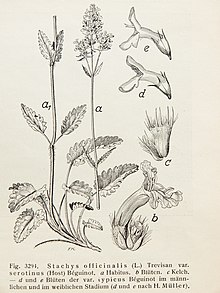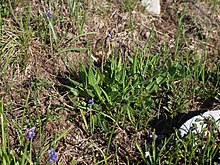Late concrete
| Late concrete | ||||||||||||
|---|---|---|---|---|---|---|---|---|---|---|---|---|

Late betony ( Betonica serotina ) |
||||||||||||
| Systematics | ||||||||||||
|
||||||||||||
| Scientific name | ||||||||||||
| Betonica serotina | ||||||||||||
| Host |
The Late Betonie ( Betonica serotina ) is a plant from the genus of Betonien ( Betonica ) within the family of Labiatae (Lamiaceae).
Description and ecology
Differentiation from other types
According to most botanical authors, the late betonia ( Betonica serotina ) belongs to the family group of the real betonia ( Betonica officinalis ) and was often only considered a variety or subspecies. From the very variable real betony, of which numerous infraspecific taxa have also been described, it can be distinguished by the clearly separated partial inflorescences, the loose long false ear, the narrow and six to eight times as long as wide uppermost stem leaf and the always existing branches (but occurs also with the real betony more frequently on).
It also has numerous exclusive features due to its shorter calyx, which is always hairy, shorter calyx teeth, as well as its distribution in warm Mediterranean locations. When it blooms four weeks later (July to September, rarely in October), the general growth form and the plant-sociological classification in subtropical vegetation types, it is unmistakable in nature, as it is not associated with real betony. On the other hand, the color of the corolla is less meaningful, but in the late betony it is not pink or purple, but pink, which is only more noticeable when compared directly. This means that it is relatively "easy to address" in the relationally complex genre of the Betonien ( Betonica ).
Vegetative characteristics
The late betony is a perennial herbaceous plant and usually reaches heights of 30 to 70 centimeters. As a hemicryptophyte , it forms a subterranean, nodular rhizome as a perennial organ. The stem like the leaves stand together in a basal rosette and are hairy with simple link hair. Stems upright to ascending, especially in the upper part with dense backward-pointing hairs (multi-cell articulated hairs, 0.4 to 0.8 millimeters). The stalks of the lower stem leaves are seldom the same, usually twice to four times as long as the leaf blade, the uppermost stem leaves six to eight times as long as they are wide.
Generative characteristics
The flowering period extends from July to September, rarely in October. The inflorescence is narrowly interrupted and made up of composite pseudo whorls in a loosely standing false ear . The hermaphrodite flowers are zygomorphic with a double flower envelope . The calyx is 6 to 7 millimeters long, slightly hairy, with 1.5 to 2.0 millimeters long calyx teeth. The crown is 10 to 17 millimeters long.
The partial fruits are 2.5 to 3 millimeters long and 1.4 to 1.5 millimeters wide.

Taxonomy
The first description of Betonica serotina took place in 1831 in the Flora Austriaca , Volume 2 by Nicolaus Thomas Host .
The species of the genus Betonica were placed in the genus Stachys for a long time . There are many synonyms for Betonica serotina Host : Stachys serotina Fritsch , Stachys officinalis var. Serotinus Bégouinot , Stachys officinalis var. Serotina Pospichal , Betonica officinalis subsp. serotina Murb. , Stachys officinalis subsp. serotina Hayek .
Anton Kerner von Marilaun described the Velebit concrete ( Betonica velebitica ) as a new species on a collection by Thomas Pichler . This is differentiated from the actual late betony ( Betonica serotina ) by its small growth habit and the very thick hairiness and was identified by Eduard Ludvík Pospichal and Gustav Hegi as an ecotype of Stachys officinalis as Stachys officinalis var. Serotina f. velebeticus Kerner classified.
Occurrence
The late betony has its main distribution in the coastal countries of the eastern Adriatic , as well as in the southern Alps (westward to southern Ticino ). It thrives in dry Mediterranean meadows on karst sites . It occurs in the south-eastern karst mountains of the Dinarides up to an altitude of 1200 meters (Leotar in Herzegovina, Vrbanje in Orjen in Montenegro).
It is also observed in Mediterranean garigues in the plant-sociological association Cisto-Ericion such as in Istria , the Kvarner golf , Dalmatia and the Pelješac peninsula in Croatia . In the higher regions of the sub-Mediterranean karst mountains of the Dinarides between Velebit, Dinara and Orjen, in the lower Montan level (Oro-Mediterranean altitude level ) it is an element of the widespread heat-loving rock flake dry sedge in communities with salsify ( Scorzonera villosa - Scorzonero-Chrysopogonetalia). Here it has the rank of a plant-sociological type of association and character .
swell
literature
- Marianne Jeker: Taxonomic and phytochemical investigations in the genus Betonica L. (= Diss. ETH. Volume 10312). Dissertation, Swiss Federal Institute of Technology Zurich, Zurich 1993.
Individual evidence
- ↑ a b c d e f Marianne Jeker: Taxonomic and phytochemical studies in the genus Betonica L. (= Diss. ETH. Volume 10312). Dissertation, Eidgenössische Technische Hochschule Zürich, Zürich 1993, p. 60
- ↑ Stachys officinalis subsp. serotina (Host) Hayek - data sheet at Euro + Med - The Euro + Med Plantbase Project according to the World Checklist of Selected Plant Families of The Board of Trustees of the Royal Botanic Gardens, Kew 2010.
- ↑ Klemen Eler: Flora Razikovalnih ploskev na Krasu. 1. Zelnate rasltine, pritlikavi grmicki. 2009, p. 26 (PDF) ( Memento of the original from April 16, 2015 in the Internet Archive ) Info: The archive link was inserted automatically and has not yet been checked. Please check the original and archive link according to the instructions and then remove this notice.
- ↑ Horvat, Glavač, Ellenberg 1974, p. 138
- ↑ Horvat, Glavač, Ellenberg 1974, p. 483
- ↑ Horvat, Glavač, Ellenberg 1974, p. 209







